
..........................................................................................................................................................................................................
power to the people
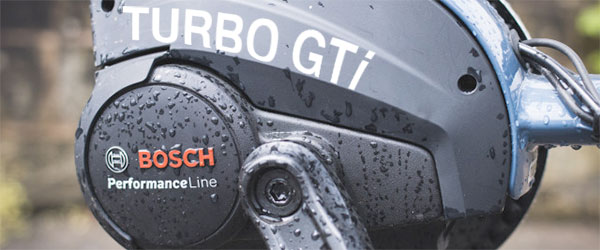
though not my first ride on an e-bike, around a decade past, i was asked to test-ride an e-bike, prior to a grant-purchase by the local leisure centre. as a result of specific funding, they had created w.i.s.p. or 'whisky island sustainability project', which put a young girl in charge of encouraging car-sharing, cycling, walking and supporting initiatives to engender more environmentally friendly means of travel. sadly, it was always doomed to failure, if only because at least one member of the leisure centre staff was in the habit of driving her car a few hundred metres to work, home for lunch, back for the afternoon shift, before driving home at the end of the day.
additionally, islay is one of those islands where motorists have long been in the habit of giving others a lift to work or to the shops; the existence of an organisation charged with encouraging what was already common practice was always unlikely to achieve a great deal. though i believe the poor girl was likely the only one who had faith in its success, my predictions of its eventual demise were, unfortunately, proved perfectly correct.
however, to return to the aforementioned e-bike, when delivered, the young girl in charge was on holiday, so the leisure centre manager asked if i would be willing to ride the bicycle to verify its quality and suitablility. many will be aware that there are currently two classifications applicable to e-bikes: pedelecs and s-pedelecs. the latter feature more powerful motors capped at around 48kph as opposed to the former, which operate at a more modest 25kph. only the slower version is currently legal on britain's roads. however, the gentleman responsible for supplying said e-bike pointed out, just prior to my heading out onto the highways and byways of the principality, that if i held down the two adjacent buttons on the bar-mounted display unit, it would remove the limiter and immediately transform a pedelec into an s-pedelec.
as if that were scarcely sufficient, the bicycle featured a throttle control capable of over-riding the pedal-assist feature, effectively turning the bicycle into an electric moped. that said, there were at least two occasions on which i had need of using the throttle due to the excessive weight of the e-bike. the oddity was in the funding of the purchase; though the leisure centre could loan the bike to 'deserving' individuals, they were prevented from receiving any remuneration in return. as a result, as far as i'm aware, the bicycle currently resides beneath the swimming pool amongst the pipework, where it has sat, unused, for several years.
much has been made of the e-bike's ability to encourage the elderly, the infirm and, to be brutally honest, the downright lazy into the saddle, reputedly encouraging an increase in fitness and health via the pedal-assist feature that is a compulsory aspect of each and every e-bike sold in the uk. that, however, might well be about to change.
the bicycle industry has, not unsurprisingly, expressed its alarm at an unexpected announcement from westminster, that they are considering substantial alterations to the legal requirements governing the sale of electric velocipedes in britain. the two key changes can be summarised by a proposed increase in motor-power to 500 watts (from the current 250 watts) and to allow throttle assistance up to 25kph. should these changes be approved, the e-bike sector would become significantly broader than at present, effectively blurring the lines between e-bikes and electric mopeds.
director of external affairs at cycling uk, sarah mcmonagle described the proposals as likely to present a huge safety risk to pedestrians. "The dramatically increased power would mean faster acceleration and much heavier bikes, which we're really concerned about." the government's seemingly flawed reasoning is that these changes would make e-bikes more attractive, but given that persuasions to have more of the population adopt the bicycle or e-bicycle as a means of transport have been predominantly based on achieving improved fitness across an increasingly listless public, neither of the two government proposals would appear to tackle that aspect of public health.
the bicycle association, which also expressed serious doubts over these proposals, pointed out that e-bikes, becoming more like electric mopeds, may subsequently fall foul of legislation requiring mandatory insurance, registration and helmets, potentially making them less attractive to those who may have considered an e-bike as an economic and healthy means of transport. let's face it; if these proposals become law, no e-bike manufacturer is likely to continue production to present day standards. meaning, essentially, that you could have elderly, infirm (or both) in charge of heavy bicycles capable of up to 48kph, bereft of the need to pedal at all (up to 25kph).
the bicycle association has questioned whether there is actually any pressing need to change the regulations. they do seem both questionable and concerning proposals, surely serving only to underline just how out of touch westminster is with modern-day transport requirements.
monday 4 march 2024
 ..........................................................................................................................................................................................................
..........................................................................................................................................................................................................return on investment
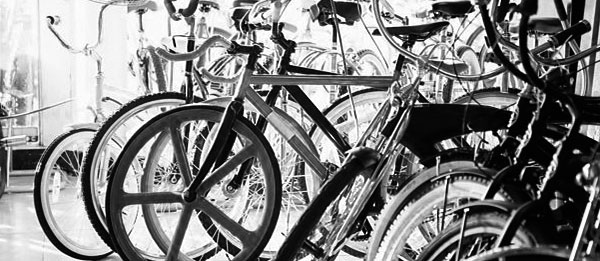
well acquainted with the trials and tribulations of early years cycling, just under a decade past, i purchased a quality balance bike for my eldest grandson. perhaps unsurprisingly (to me, at least), his parents spent less time ensuring that he experienced a requisite amount of time appraising his tender limbs with the skills that would ensure a lifetime of cycling fun. though the cycle was used, i believe the term for which i'm searching is minimal.
a year or two later, when visiting the croft at christmas, his parents presented him with a brand new bicycle on which his grandmother and i were disappointed to note, was a pair of stabilisers, effectively undoing any benefits that may have been gained from riding the balance bike. to add insult to injury, the bicycle was already verging on being too small; on his first nearby ride, the seatpost was already set at its height limit. and as if that was insufficient, the bicycle had been purchased from a nearby supermarket 'because it was cheap'.
it seems that having a father who has exhibited an obsession with bicycles since my daughter was three-years old, and could have offered what amounts to 'expert' advice, had apprently slipped her mind.
those of us who consider ourselves to be paid up members of cycling's cognoscenti will no doubt be au fait with velocipedinal economics, with specific regard to the relative costs of new bicycles. well do we know that, while mail-order and supermarket bicycles may appear to offer highly economic purchase prices, actually buying one will almost certainly result in examples of false economy. i dare say we all have recollection of one particular supermarket which displayed a kid's bicycle in store featuring the forks positioned the wrong way round, sporting a brake caliper that faced rearwards.
when the majority of new bikes arrive in cardboard boxes clearly stating on the top that, if not assembled by qualified personnel, the warranty is likely to be null and void, placing one's faith and cash payment with the local supermarket seems like a parlous mistake.
however, when faced with the inevitable query from friends and neighbours as to what would be an appropriate cycle purchase for either themselves or their offspring, confidence in our response is almost always undermined by our own lack of confidence in low cost bicycles. it came as no succour to one such inquisitor when i pointed out that the seatpost on my own bicycle had cost more than the price of the entire bicycle they were planning to purchase. you can imagine the reaction that engendered.
thankfully, those of a similar mind have carried out a lengthy, practical experiment in order to prove that with which we are all already familar. though the experiment was conducted in australia, i'm of the opinion that the result is valid across both hemispheres.
australia's equivalent of which? purchased two supermarket bicycles that cost, on average, nigh on 300 australian dollars less than a merida speeder and a norco yorkville. four cyclists then rode the bikes for around six months over distances varying from 600km to 1400km. during that period, the cycles were regularly checked by qualified mechanics. it is partcularly instructive to learn that, even before riding began, the mechanics had to make a whole series of correction to the supermarket cycles before they were ready for the road.
servicing was carried out on all four bikes after six months, at which point both the merida and norco were adjudged to be in good condition and fit for continued riding. the supermarket bicycles, you will be completely unsuprised to hear, were not. on one, the front brake caliper had failed completely, and soon after, the rear caliper was replaced before it too, capitulated. during the six month test period, this particular bike required 140 dollars of replacement parts.
the other supermarket example had already begun to rust within the first couple of weeks, and on each service, the bottom bracket had loosened, causing the chain to fall off. additionally, the front wheel had developed a wobble that caused it to rub on the brake pads. the test mechanic stated, "The most disappointing problem with this bike is the poor quality of the materials. The entire bike is rusting within the test's six-month duration. There is rust appearing on the frame, the handlebars, both wheel hubs, the spoke nipples, the cranks, and the brake calipers."
at the end of the test period, the total cost of ownership showed that both the expensive bikes had required only one service, but no replacement parts. both supermarket bikes had required three repair services along with replacement parts, meaning that a 189 dollar bike had effectively cost 787 dollars, almost 100 dollars more than the more expensive of the bike shop purchases. it seemed highly likely that, were matters to continue on this trajectory, within a year, both supermarket examples would exhibit considerably higher costs than those with an initially higher purchase cost.
of course, such matters are always going to be subject to the law of diminishing returns; in other words, the more you spend on a bicycle, the less likely are the economics to add up in your favour. of course, that is to exclude the quality factor, though it too is subject to the same law. as the cognoscenti, we are also aware that the same overall situation applies to other sections of the velocipedinal firmament, such as cycling apparel and componentry, facts that have revealed themselves time after time during the years in which i conducted reviews. i have helpfully included below, a link to the full article in case you happen across some non-believers.
read the full article here
once again, thanks to richard peploe for highlighting this.
sunday 3 march 2024
 ..........................................................................................................................................................................................................
..........................................................................................................................................................................................................granite rock'n'roll torque wrench tool kit

it is not entirely unreasonable to posit that the torque settings, in newton-metres (nm) frequently to be seen on contemporary bicycle components, are an insurance policy created by the manufacturers of said components. this is particularly evident where carbon is concerned. for instance, though a tad indistinct following several years of use, the seatbolt collar on my specialized crux would appear to suggest that 15 newton metres of force is required to ensure it remains in place during the riding process.
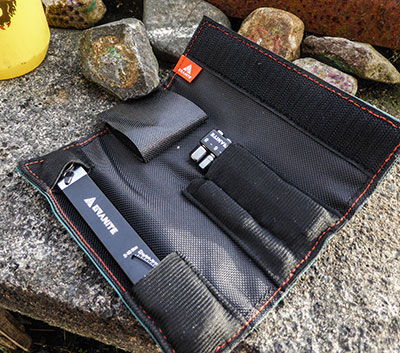
the seatpost in question is, however, fashioned from less than fragile aluminium alloy, so any dangers to be experienced from a smidgeon of overtightening (based on the anecdotal knowledge that few cyclists are in possession of an appropriately calibrated torque wrench), are likely to be minimal at best. not unlike the riders tangentially referred to above, i'm mostly in the habit of tightening the seatpost bolt until it won't tighten any more. i should perhaps point out, however, that this is accomplished using a small 4mm allen key, one that is unlikely to exert enough force to damage either component.
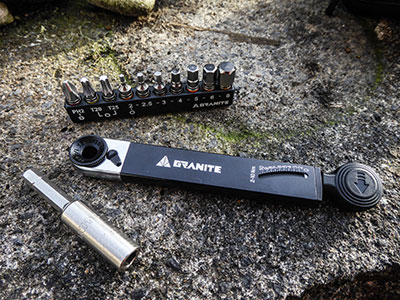
but swap that alloy seatpost for a carbon one, and matters may be a little more complex, given the fragility of carbon fibre when pressured in a direction in which it was not designed to withstand pressure. seatposts are remarkably strong in a vertical direction, yet potentially less so when squished laterally. i've used the example of a seatpost because, if you're anything like eddy merckx, you may be prone to faffing, in an attempt to find the ideal height.
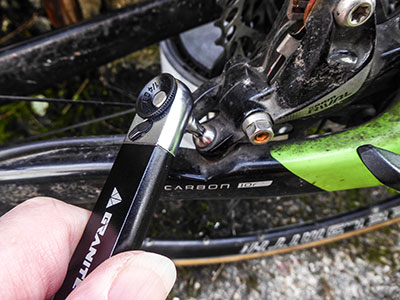
by the very definition of the latter, attempts to set a perfect height are more than likely to take place while out riding, many kilometres from home. tightening stem faceplate bolts, disc caliper bolts and even the very bolts that hold the brake levers to the handlebars are likely to be the subject of installation and tensioning while the bicycle is still within shouting distance of the bike shed. in which case, the more conscientious amongst you may have recourse to a designated workshop torque wrench, the very item highly unlikely to fit in a jersey pocket.

as you may have surmised by now, torque settings are no respecters of geography, entailing the possibility that any necessary adjustments required on key componentry en- route to anywhere in particular, might otherwise be found wanting. which is exactly where granite's rock'n'roll, compact and bijou torque wrench steps into the fray.
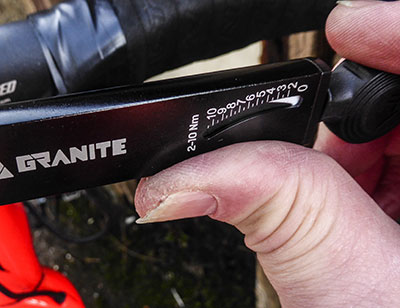
contained within a tough polyester fabric tool roll (which can be attached to a belt if need be) is a sturdy, well-designed torque wrench, accompanied by ten bits of varying sizes which fit seamlessly into the socket head incorporated into the wrench. allen keys from 2 to 8mm are augmented with t20 and t25 torx bits and a no. 2 philips screwdriver head. the wrench itself features an ingenious torque gauge allowing bolts to be tightened from 2nm to 10nm. a tiny lever below the socket insert allows the wrench to be used to tighten or loosen your bolts of choice.
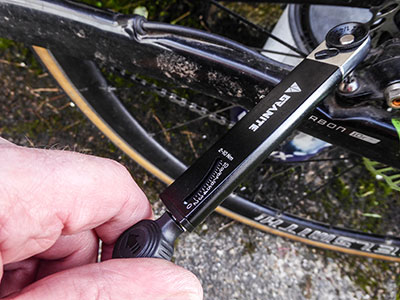
there's also an extender to aid access to recessed bolts.
in operation, having fitted the appropriate bit, the wrench handle can be used to install a compatible bolt up to the point where it begins to require noticeable leverage. at this point, twisting motion is transferred to a round torque lever at the base of the wrench. as this meets resistance, a white indicator line appears in a window slot in the body of the wrench, allowing visual measurement against a marked torque scale. when the white indicator line matches the bolt's recommended torque setting, the job is complete. it's possible to tighten bolts requiring more than 10nm by holding the wrench handle alone as opposed to using the torque module. however, anything above 10nm is outwith the measuring scope of this particular device.
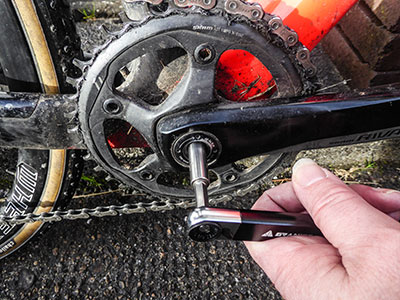
given that the tool pouch fits easily into a jersey or jacket rear pocket, it is simplicity itself to conveniently carry the tool anywhere you and your bicycle wish to go.
and it really works; the stem faceplate bolts on the specialized require 5nm apiece, and on checking, i learned that i had insufficiently tightened three of those bolts. fortunately, my guesstimation of the torque applicable to the torx bolted disc calipers was barely out by 1nm.
the more carbon fibre components you have festooned about your bicycle's person, the more desirable it is to own such a device. should one of those components fail in use, referring back to my contention that torque measurements are the manufacturer's insurance policy, any warranty claim is likely to involve demonstration that the fitting bolts were tightened to the correct torque setting. if carried out by a qualified bicycle store mechanic, there's unlikely to be any prevarication, but if you've carried out the installation yourself, or had cause to indulge in faffing while out in the wild, you may find the manufacturer's response to be a tad more inquisitive. otherwise personal replacement of a damaged component could conceivably cost more than the very reasonable £54.99 price tag on the rock'n'roll.
i will never leave home without it. it's good to torque.
the granite rock'n'roll portable torque toolset is distributed in the uk by windwave

saturday 2 march 2024
 ..........................................................................................................................................................................................................
..........................................................................................................................................................................................................tired

i own a pair of deep carbon-rimmed wheels; 45mm to be more precise. aesthetically, they are very pleasing indeed; pragmatically, they leave a lot to be desired. in truth, i am insufficiently possessed of the old get up and go to make use of their proffered benefits. it's eminently possible to slice through atlantic gales with aplomb, but unless that front wheel is slicing at right angles, it becomes a case of houston, we have a problem.
granted, these wheels have been reputedly wind-tunnel tested to within a millimetre of their yaw potential, supposedly capable of shrugging off crosswinds that dare to attack from oblique angles. however, i can but wonder at what strength those wind tunnel tests were carried out. though it appears possible still to ride in variations of the straight line principle at wind speeds of up to 75kph, if i said that i was comfortable doing so, i would be guilty of a big fib.
the problem, which eventually led to the acquisition of a more traditional wheelset with a sensible number of spokes, pertained directly to hebridean weather patterns. saturday, for instance, may have been clear and relatively windless, while sunday morning may dawn grey and wind-strewn. unless arising at the crack of dawn, there was simply no time to switch from deep carbon to sensible and still join the sunday peloton at the appointed hour.
i would dearly love to tell you that, come summer season, the winds would have abated sufficiently to allow for deep carbon perambulations, but once again, that would involve relating yet another big fib. thus, those carbon rimmed wheels have been effectively sidelined in favour of double-butted spokes and mavic open pro alloy rims. whether windy or still, those will, as is said in certain circles, cut the mustard.
it is not unusual for any contemporary cyclist to possess more than one pair of wheels for one bicycle. some may have several sets. however, what might complicate matters to a hitherto unheralded degree, would be an array of tyres, curated specifically to cope with changing road conditions. though i may be mistaken, i cannot recall any professional cyclist making a mid-race bike change in order to ride tyres more suited to changing conditions. there must be many races in any given season on which the weather conditions change from dry to wet before the finish line is in sight. yet our heroes continue their respective trajectories with scarcely a thought for the tread on their tubulars.
cyclocross is entirely different. it is the one genre of cycle sport in which the pre-race conversations and commentary involves detailed analysis of which tread pattern on each rider has decided to start. this situation is undoubtedly eased by the placement of two pit areas in which it is perfectly legitimate to change bicycles. for those riders contracted to ride challenge tyres the choice is to opt for limus, baby limus, grifo or chicane, depending on parcours conditions and how those almost inevitably change during the ensuing sixty-minutes. those riding dugast tubs can choose from rhino, typhoon, pipistrello and pipisquallo (who knew that dugast also made clinchers?)
winning a race can easily depend on correct tyre choice.
i am willing to accept that course conditions in cyclocross can be considerably more challenging than your average paris-roubaix, but even during the latter cobbled monument, i do not recall riders changing wheels en-mass if a dry start became a wet finish. but as professional road-racing becomes ever more technically challenging, from nutrition to aero to gearing, is it possible that the only remaining variable might be that of tyre choice?
formula one motor racing often portrays drivers diving to the pits the minute the heavens open, and then again, should the clouds disperse. winning on wet tyres during a dry race is, i believe, unheard of. in which case, could that be the next stage in achieving marginal gains? might it benefit the more astute rider or team manager to switch wheels/tyres mid-race, providing the ultimate edge over their competitors? might it also add a delightful frisson to proceedings, watching team mechanics armed with black and decker drills removing thru axles for timed wheel changes?
or has the uci outlawed that in advance?
friday 1 march 2024
 ..........................................................................................................................................................................................................
..........................................................................................................................................................................................................off grid
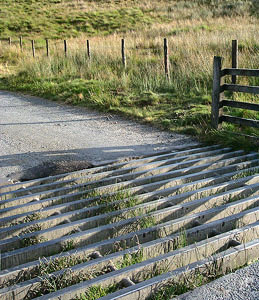
i have ridden in london's fair city on two separate occasions, neither of which would encourage me to repeat the experiences. the first was an attempt to join rapha's hell of the north, an event offering the intrepid amateur the chance to celebrate paris-roubaix over a distinctly less cobbled, but thoroughly british parcours. this particular unnerving velocipedinal experience was, i'm embarrassed to say, somewhat self-inflicted. having arranged to meet one of rapha's designers at an appointed time and place, i then (wrongly) thought i may have missed our meeting, and set off, solo, in the mistaken assumption that i was heading in the right direction to catch up.
london cyclists will laugh at such a schoolboy error. suffice it to say, i was still some considerable distance from the start point, when my prospective companions were due to have left the starting point.
a few years later, i was invited to join an edition of the tweed ride around the streets of britain's capital city. having identified the start point, i set off, guided entirely by a printout taken from google maps. this, i discovered en-route, was a mistake; google maps did not, it transpired, feature every road passed along the way, meaning that i very quickly got lost and ended up riding the wrong way down a one-way street. it was only my spying what i (correctly) assumed was another tweed ride cyclist, that bailed me out in timeous manner, after following him to the grand départ. thankfully the ride itself was well curated, though i cannot deny a certain level of anxiety on trying to find my way home.
the obstacles i experienced along the way on both occasions were not entirely unexpected, but did give continual concern at every twist and turn. london's streets are undoubtedly an exaggerated example of the trepidation a lad from the sticks might encounter during an unaccompanied bike ride. a bit, i imagine, like expecting each and every american city to replicate new york. though i have not ridden in either glasgow or edinburgh, where the obstacles are similarly formed, purely from observation and anecdotal evidence, both would probably prove a tad less worrying than london town.
i have ridden considerable distances across portland, oregon, on every occasion, a great deal more pleasant than any british city or urban setting. however, that is undoubtedly the result of having carefully crafted a city specifically to cater to a substantial cycling public. even when riding on the wrong side of the road, i rarely, if ever, found myself under threat from the surrounding traffic. it should also be pointed out that portland is considerably less claustrophobic than london's pavements paved with gold.
however, it appears that, when it comes to more rural cycling, where you'd think the lack of traffic and wide open spaces would encourage greater confidence in the city or urban velocipedinist, that's not always the case.
in 2015, the esteemed richard goslan of the scotch malt whisky association engendered the tour de islay during which a small peloton, including yours truly, successfully visited each and every distillery on islay. the ride has only been repeated once since and i have no knowledge of its uncertain future. however, during that first event, we were accompanied by a stills photographer and a videographer, the results of which can still be found on youtube. the group also consisted of two other considerably experienced cyclists.
having left ardbeg a tad later than intended, we visited both lagavulin and laphroaig before taking the glen road north to caol ila and subsequently, bunnahabhain. this single track route features number of cattle grids, on the approach to which, one of the riders came to a grinding halt, before enquiring as to how one would traverse just such an obstacle?
shuffle forward almost a decade, and it appears that the cyclist in question was not a solo naiveté. in the process i have learned that urban dwellers can be referred to as urbanites. according to a survey undertaken by direct line car insurance, a third of british urban drivers have frequently made diversions of up to 8km in order to avoid cattle grids, the purpose of which they are utterly unaware.
the poking of fun by those of us to whom cattle grids are scarcely worth a mention continues on learning that 21% of younger drivers believe cattle grids might be responsible for damaging their vehicles, despite incidents reported to local councils sitting at less than 10%. the same report then castigates local authorities for their apparent reluctance to install new cattle grids.
based on the experience outlined above, it seems every bit as likely that there are urbanite cyclists who also live in dread of encountering a cattle grid, so for those who count themselves amongst that number, allow me to briefly explain. cattle grids form a series of parallel metal bars sited at right angles to the direction of travel. these sit atop a hole in the ground. their original purpose is to prevent cattle and/or sheep from crossing to a part of the countryside their owners would prefer to keep out of bounds.
it's the spaces between each of the metal bars that confounds the animals, unable to co-ordinate their four limbs to step only upon the bars and avoid the gaps in between. by and large, they prove effective, and there are several homesteads on islay that feature cattle grids at the entrance to their driveways, intent on preventing sheep or cattle from romaing their gardens and eating every plant within sight. that said, i have seen several sheep lie-down and roll across a grid, along with witnessing similar woolly animals jump clear across to the other side.
location of cattle grids is usually identified by local farmers, but once in place, they become the responsibility of the local council. should one of the older models fall into disrepair, the council will generally consult with nearby farmers to ascertain whether the presence of a cattle grid is still desirable. more than a single example on islay has been removed and the hole filled in as a result.
and to return to the original question posed above, on reaching a cattle grid by bicycle, simply raise your posterior from the saddle to lessen the discomfort and roll across at moderate speed, ensuring that, at no time, does the front wheel exhibit a tendency to turn to the left or the right. believe me, you do not want to have the wheel drop into one of the gaps. riding across is not only quicker, but considerably safer than dismounting and attempting to walk across. if the grid is one of the older models, where the steel bars exhibit a square cross-section (newer ones are often round), just be careful if wet (who am i kidding? this is scotland; they're always wet).
i and my sunday morning colleagues have been riding across cattle grids for more years than we care to recall, all without incident. i even regularly rode a sequence of six cattle grids on a bicycle featuring a pair of very expensive lightweight carbon wheels shod with competition tubulars, all without incurring any damage whatsoever.
according to direct line, the worst place to ride for those with grid-ophobia would be the shetland isles which reputedly features a total of 390 cattle grids (and has only received a single complaint), dwarfing the mere 161 installed across argyll & bute and which has had 28 complaints in the last three years.
you're welcome
thursday 29 february 2024
 ..........................................................................................................................................................................................................
..........................................................................................................................................................................................................dehumanising

though i regularly scrabble through a wide range of youtube videos, predominantly of a percussive nature, i have found myself frequently alighting on those produced by rick beato, a popular and erudite musician and producer, who has an excellent knack of interviewing the great and good from the world of contemporary music on the basis of being every bit their equal, minus their reputed star quality. he has spoken at length to sting, andy summers, brad mehldau, and arguably less famous record producers. the most recent viewed by yours truly was an interview with bass player, lee sklar, most likely to be recognised as the bass player of choice for phil collins.
sklar, now in his mid-seventies, is a renowned session musician who has worked with the best of the best. during the course of the interview he makes regular mention of drummers steve gadd and the late jeff porcaro, the latter cited as a particular favourite. however, when the conversation brought together the categories of musicality and drummers, sklar immediately interrupted to state that he was under the impression they were talking about musicians.
adjoined by laughter, sklar was referencing the long-running sparring match that has existed between bassists and drummers stretching back for as long as anyone can recall. both are instrumental (pun intended) in the success of umpteen recordings; the majority of modern pop and rock music relies on danceable rhythms, frequently provided by the so-called rhythm section. as a percussionist of lengthy provenance, i am well-used to being disparaged in such a manner, one that bears similarities to those often aimed squarely at cyclists. the difference is probably that of humour.
an australian study originally carried out in 2019 and revisited only last year, revealed the rather disappointing result that many car drivers see cyclists as 'less than human'. while i'm sure we can all think of a fellow cyclist who might just fit that description, the serious result, potential or otherwise, might be that the only thing preventing us from being despatched to an uncertain fate by a passing motorist, is that any infraction might affect their no-claims bonus.
as we have discussed at length, my island domicile is remarkably different from many an urban or inner-city setting, but even i have encountered car drivers whose behaviour suggests that i am guilty of simply getting in their way, and one or two who gave every indication of scarcely having seen me at all. for those living and cycling in the conurbations mentioned above, either of those situations must be a daily or hourly occurrence. that does, however, beggar the question as to why said motorists appear to view their fellow human beings as expendable in the face of their considerably more important travel plans.
in the main, however, this is not a situation with which i and my fellow island velocipedinists can directly relate, which i have accepted is as a direct result of the community in which we live. the population of islay hovers around the 3,000 mark, meaning that the majority do actually know their co-islanders; who they are, where they work and why they might be riding a bicycle in front of them. in towns such as portland, oregon, it was mentioned that critical mass might have been achieved, where the cyclist in front might just be the neighbour from two doors down. that, to place not too fine a point upon it, personalises the whole situation.
islay's remarkably small peloton of cyclists has pretty much achieved similar status. the oft mentioned 'islay-wave' entails that drivers and cyclists tend to wave to each other on passing, an act that appears to be unique to islay, but serves to personalise daily communication. sadly, in areas of much larger populations, cyclists are often identified as an irritation to the more self-important motorist, whose reasons for travelling are seen as infinitely more significant than those on two wheels, even if their destinations are the same.
matt de neef's article on escapecollective.com claims that "The non-cyclists didn't just dislike cyclists or find them annoying on the road - they saw cyclists as less-than-fully human, less-than-fully evolved." disturbing though that is, there will be many cyclists who were already aware of just such a situation. the problem- and it's no different in the northern hemisphere - is just how to change that apprehension. it will come as little surprise to learn that "...cyclists in photographs were labelled as less human if the rider was wearing a helmet, high-visibility vest, or Lycra, compared to riders wearing just a T-shirt." not from nowhere arrived the description 'lycra-louts'.
the late lord carlos of mercian spent many a long year determined to remain a bloke with a bike, rather than succumbing to the mores of being recognised as a cyclist. however, following his first sportive ride, he acquiesced and began wearing padded bibshorts and jerseys with three rear pockets, acknowledging that the sunday ride had become more comfortable in the process. the simile would surely be that few, if any, go swimming in a pair of levis 501 denims.
it may have ameliorated the situation slightly when rapha first brought sportwool to the masses, conferring a less pelotonic hue upon the cognoscenti (sadly, their present day offerings have all but reversed the situation), offering comfort with style. in britain there is still the faint hint of a class system that reckons that cyclists are of a lower order, unable to afford the motor vehicles driven by their lords and masters. perhaps that's why mathieu van der poel arrives at cyclocross races in a lamborghini.
in an almost perfect illustration of 'everything that's for us is against us' the report concluded that the best means of dispelling this characterising of cyclists as 'less than human' is to get more folks on bicycles. the rather large fly-in-the-ointment, however, is surely the fact that, until the infrastructure exists that might support such a recruitment to the cause, apprentice cyclists will undoubtedly have to suffer the very slings and arrows of the motoring public, that may have kept them off the saddle in the first place. successful examples such as portland and islay, to name but two, surely demonstrate that it is doable; the former is perhaps more relateable to the majority. but nonetheless, the solution is hardly just round the corner.
maybe we should just pay road tax?
photo: cycling uk thanks to richard peploe for the heads up
wednesday 28 february 2024
 ..........................................................................................................................................................................................................
..........................................................................................................................................................................................................changing lanes
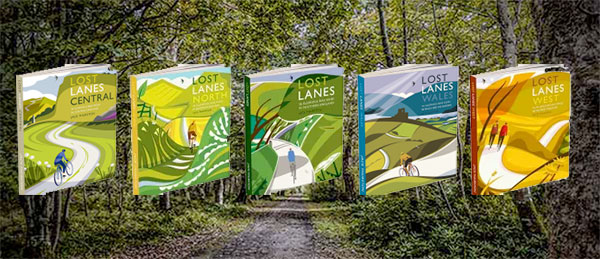
i have the greatest of admiration for jack thurston, he of the lost lanes series of books, which, despite being thoroughly contemporary, describe a form of cycling that harkens back to the halcyon days of yore. i may be somewhat wide of the mark when it comes to appreciating the style of velocipedinal activity that permeates those particular books, but it often seems that so-called slow cycling, is no longer the activity it once was. if evidence were required in support, you may recall a washingmachinepost article from last week, where i quoted the statistic indicating that 28% would feel more inclined to adopt cycling, were it faster and easier.
my own conclusion has me wondering what on earth was the question that returned such an answer, and how accurately was it interpreted?
there still lives, at the back of the bikeshed, a taurus corinto steel roadster, powered by a sturmey-archer three-speed gear. i have always envisaged that to be the ideal perambulator on which to emulate mr thurston's philosophical vision for the contemporary cyclist. it does occur, however, that such machinery might be taking things just a tad too far, but i confess i'm unable to test that theory due to a plethora of broken spokes on the rod-brake enabled, italian bicycle. granted, it does feature a couple of brooks roll-up canvas panniers affixed to its sturdy rear carrier rack, but without the spokes, those are somewhat superfluous.
however, the over-arching problem in framing my prospective emulation difficulties, is, at least in part, the lack of leafy lanes about the principality. granted, if riding along the southern single-track roads past ardbeg distillery, there can be appreciable tree-cover from spring onwards. the road i describe leads towards the kildalton cross in the grounds of the ruined kildalton chapel, and is a particularly enjoyable bike ride if we tactfully exclude the short, but excruciatingly steep exit from loch a chnuic. meeting a vehicle heading in the opposite direction and forcing a dismount, pretty much guarantees a steep walk for a few metres. it really is too steep to get moving once again until the road levels out.
additionally, the earlier descent towards the dower house and the aforementioned sea loch provides a steep enough return, to which a three-speed sturmey is considerably less than equal. add to that, the not inconsiderable distance to reach the area from bowmore (around 33km) would surely render moot, any thoughts of velocipedinal meandering in the first place?
however, i fear that the principal barrier to my becoming a true thurston acolyte, is a continued persistence in riding a less than relaxed road bike, with no appendages that might encourage the fitting of panniers or a bar bag. (it is my firm belief that bikepacking bags are the very antithesis of the cycling mode with which i wish to become familiar). do not misunderstand my motives; i greatly appreciate the availability of a bicycle that will allow me to test my ageing mettle against the elements, maintaining a level of fitness that allows that state of affairs to persist for as long as possible.
but...
there is a nagging suspicion that, not only might i begin to acquire flabby bits and a less capable cardio-vascular system were slow to become the word of the week, but that my delight in watching cyclocross and the spring classics, might either break some unwritten and hitherto unknown code of conduct, or evaporate altogether. i'm not sure that, even in my advanced years, i'm ready for that to happen.
it occurs, however, that cycling appropriately along any of islay's lost lanes, might depend greatly upon a particular state of mind that i have utterly failed to adopt. the choice, as i see it, is which might require less effort; continuing to ride at the edge of my admittedly modest abilities, or achieving a calmer state of mind that might equate better with that which i profess to desire.
what would wout do?
jack thurston's lost lanes book series
tuesday 27 february 2024
 ..........................................................................................................................................................................................................
..........................................................................................................................................................................................................